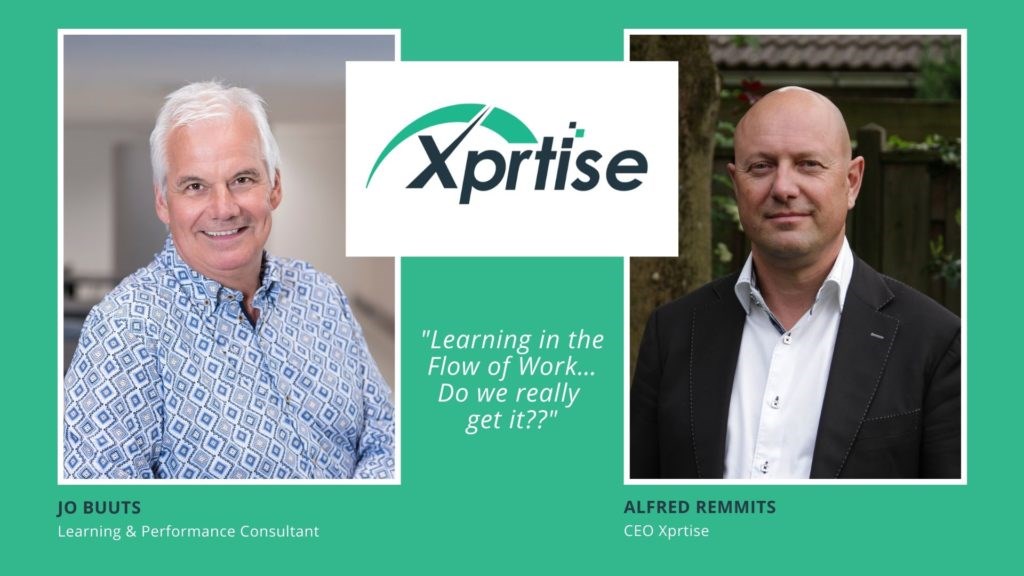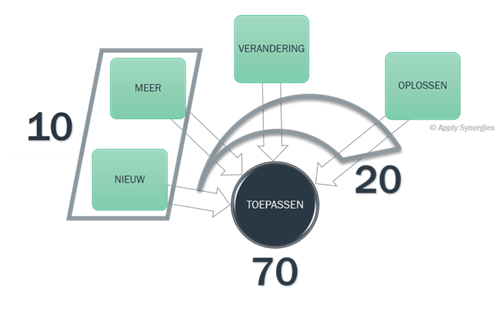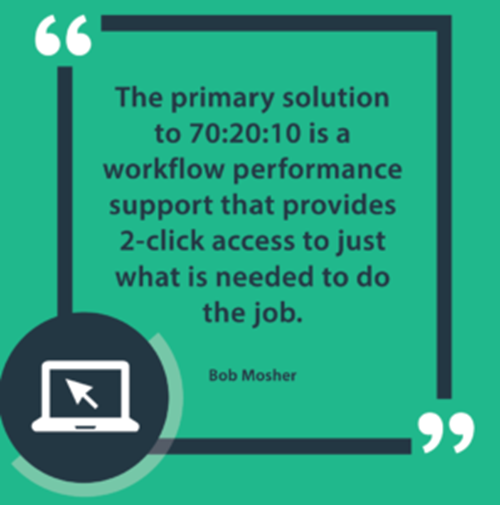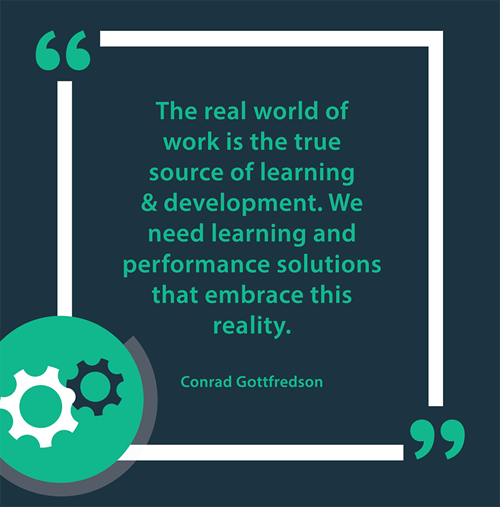
CEO Alfred Remmits and the Xprtise team have, for the last 5 years specialized in designing and implementing workflow learning solutions in the Netherlands, the US, and Europe. Jo Buuts is an independent Learning & Performance consultant and shares with Alfred the belief that truly successful workflow learning is more than just transporting traditional learning forms and resources to the learner at work.
Recently Alfred and Jo got talking about the characteristics of real workflow solutions and how they’re different from traditional training. What it means for design and development of these solutions, for measuring results and what technologies properly support them.
Jo Buuts:Workflow learning is a hot topic. For a lot of professionals and self-appointed experts though, that just means bringing traditional training methods to the learner at work. Old wine in new bottles, right?
Alfred Remmits: Indeed, I get the feeling lately that L&D professionals, consultants, and vendors don’t understand the essence of workflow learning. Their approach is to extend traditional forms of training and serve them up on the job. In practice, this means repackaging (shrinking) content from e-learning or training modules, to make them more consumable. In organizations I speak to, workflow learning is often interpreted as moving the teacher into the workplace, teaching by the machine, or by a patient’s bedside in the hospital. On websites vendors offer standard or customized e-learning solutions, under the heading of workflow learning or even as performance support solutions. These really don’t reflect what a real workflow learning or performance support solution should be. Old wine in new bottles, yes, because they focus on learning in the sense of knowledge acquisition, rather than learning that supports the performance of employees in their flow of work. That’s what organizations should be focusing on.
Jo Buuts:It’s a pity, large organizations are also seeing that this generic interpretation of workflow learning is failing to achieve their strategic goals. Are they missing an opportunity?

Alfred Remmits: I think so. Larger organizations in particular understand the rudder has to shift to establish new ways of learning at work. That explains the popularity of the 70:20:10 framework. In the last 5 years I’ve seen many organizations in the US, in the Netherlands, and Europe, adopt 70:20:10 as the guiding principle when designing their learning solutions. But what we often see is that many of their solutions don’t really fit into the 70, but still linger in the 10. Extra support in the form of coaching or mentoring, there’s the 20. Stretched assignments and moments of reflection, somewhat below what’s needed in the 70. Both valid activities, but too limited to support employees while they do their work, where according to the 70:20:10 model, most of the learning takes place.
As there isn’t a good design methodology for the 70:20:10 model, it’s hard to design the right solution for the 70 especially. As a result, most of the initiatives I’ve seen in companies in recent years don’t go beyond what I’d call blended training. The main goal being to shorten the formal training time, rather than to properly address an employee’s learning journey. As such, opportunities are indeed missed to really support employees in their day-to-day work, to help them improve their performance on the ground.
Jo Buuts: This repackaging of content produces short chunks that are available to support the learner while they work. Is that learning in the workflow?
Alfred Remmits: Just transporting short pieces of content from the classroom to the learner at work is only part of the solution. As in the well-known so-called micro-learning. This is typically just traditional e-learning and videos, shortened to bite-sized chunks of 1-2 minutes. Made available through a Learning Management System (LMS) or perhaps a Learning Experience Platform (LXP) with an innovative User Interface (UI), may or may not be supplemented with mentors, coaches, and supervisors in the workplace. Still delivering on the traditional master-student approach. This doesn’t work though, as it almost entirely lacks any connection with the person’s work context.
Jo Buuts:What do you see as the effects of that approach in practice?
Alfred Remmits: Learning Technology providers bring advanced solutions to the market that make it easier to transport traditional learning methods into the workplace. With improved UI and the ever-intelligent Artificial Intelligence (AI), we can analyze user behavior. As a result, content can be brought to the attention of the learner more effectively. An example of this, the so-called Netflix of Learning model promoted by almost all providers of LXPs such as Degreed, Edcast, and Fuse who recommend content also used by others in the study of a particular topic. The content offered is based on user profiles, but what is lacking in almost all of these systems is the context of the work processes and within them the work tasks. That approach always leads to an abundance of information, the word itself means plenty. But I don’t see people when needing to solve a problem, scroll through a large number of learning objects while at work, to find and study the most relevant topic for them. The choice is too big and this approach lacks behind it a thoughtful design methodology. What people need is the right content to solve a specific problem as quickly as possible, based on the context of their work, the specific task they want to perform in their specific work process.
Jo Buuts:The use of this technology encourages that old approach to be maintained, I think. Consultants and trainers can continue to offer their services in almost the same way.
Alfred Remmits: And that’s what they do! Learning consultants are offering content shortening/repackaging services to repurpose it for the new technology. I heard that a large Pharmaceutical group guided by one of the world’s top learning consultancies, had all their existing e-learning content shortened to micro-learning. To be better used during work. Talk about old wine in new bottles. Training agencies are also shifting their scope of activity from the classroom to work. They come with new products with sexy names like stretch assignments, mindfulness in the workflow, and reflection coaching. All of this has very little to do with workflow learning.
Jo Buuts:Not that innovative indeed. Moreover, the needs of organizations – to learn in the flow of work – are not met in this way. Missed opportunities, then. Where do you think the cause lies?
Alfred Remmits: The underlying problem is a lack of vision of what learning means, where, and when it takes place. That limited view leads to the design, development, and organization of learning in a format the same as we have been doing for the last 50 years. In an increasingly turbulent environment where knowledge is falling in value faster and faster, we still teach in classrooms, but now with a virtual teacher on your screen. We still do e-learning but shortened to micro-learning of one to two minutes each. To continue to confirm the success of this approach, we measure how often the source is clicked on and how the learner evaluates the content, through happy sheets, numbers of participants attending, and time spent on the e-learning module. The focus is still on content and resources rather than on context and impact on business performance.
Jo Buuts:How do we break that self-reinforcing way of thinking?
Alfred Remmits: The rudder will have to turn. We need to understand we need a completely different approach to design, develop, implement, and measure workflow learning. And that goes for all four of these aspects, you can’t pick one or two at will.
Jo Buuts:Let’s start with the design, what’s the big difference with the design?
Alfred Remmits: We need to design solutions for the entire learning journey of our employees, from novice to master, but it also needs to address their continuous every-day learning needs as they cope with changes in their workplace. Learning cannot be summed up as a one-off learning event. Learning and working are inextricably linked.
I have been working with Bob Mosher and Dr. Conrad Gottfredson, the creators of the 5 Moments of NeedTM methodology, for over 15 years. The methodology yields a mix of solutions for the entire learning journey. This is possible because the design approach understands the context where the majority of learning takes place, is on the job, in the flow of work. So a significant proportion of the content and resources should be available to support that work process. Serving content in context.
When designing for the 5 moments of need journey, you first consider how to support employees when they execute their tasks (Apply), when they problem-solve (Solve), and when they respond to changing situations (Change). Only then do you consider if anything new (New) needs to be learned, or if more depth (More) is required. Another key difference with the design process is the distinction made early in the analysis phase between what are critical tasks and what are important tasks.
Jo Buuts: Traditional training design does distinguish the importance of a task…what exactly do you mean here?
Alfred Remmits: Traditional designers consider the importance of a task to determine what content and how much should be developed. That emphasis on content again. The 5 Moments of NeedTM method focuses on the criticality of a task to assess where and when – in what context – content should be offered. Highly critical tasks may need formal training as well as learning the workflow. Less critical tasks can be delivered solely in the workflow with a performance support system, without relying on intensive training or expensive e-learning.
It seems to be a small difference but one with big impact. With this method you have a proven, objective method to convert what may previously have been a five-day course into a truly blended, workflow learning solution.
Jo Buuts: So we need to develop solutions that enable employees to perform tasks, solve their problems and cope with changing situations while in the flow of work… Are the design and development tools L&D professionals are using, the Adobe Articulates, the Moodles, the right tools for this purpose?
Alfred Remmits:We need more than this. In the same way that a whiteboard, a trainer/designer, and PowerPoint are the tools to develop a classroom event, now we must consider the tools that support employees in their flow of work. The most important tool is a Workflow Learning EPSS (Electronic Performance Support System). There are a few of these on the market. What you need is a powerful and innovative system that fully supports this new approach. Where a visual work process map – an overview of tasks and steps within a defined work process – is the starting point for contextual accessibility of the right, relevant content, for that moment. A technology that ensures the employee is supported through all their 5 Moments of NeedTM.
Jo Buuts: So workflow learning means that content is used when people are performing tasks, solving problems, and responding to new situations. In other words, as they are working in the 70 of the 70:20:10. Does that also mean a change in the format of the content?

Alfred Remmits: Learning while working is truly the most powerful form of learning. But it is completely different from the way we have developed courses and resources for the last 50 years. When you work in the moments of Apply, Solve, and Change, you are often alone. You certainly don’t have time to follow 12-minute e-learning, watch a 7-minute video, or read an extensive PDF. You want help, now. You want a solution that immediately puts you on the right track, in two clicks, 10 seconds. And not after 20 minutes be left with all kinds of other resources, even if they are recommended by others. Resources and content should be short, to-the-point, correct, and relevant to performing that particular task and solving that particular problem.
Jo Buuts: The LMS is a standard technology for L&D practitioners, and the LXP is on the rise. Are these systems suitable for this approach?
Alfred Remmits: It may be claimed by vendors, but an LMS or LXP is not suitable for this. IT departments also want you to believe that you can unlock the necessary content with SharePoint. An LMS supports the development, management, and provision of formal training and e-learning while providing insight into the degree of use of the content. An LXP goes a bit further by involving the learner more and by responding more adaptively to employees’ learning needs. It makes combining formal and informal sources easier for the employee. But what you really need is a Workflow EPSS.
Jo Buuts:We talked earlier about measuring results. Not the easiest part of the L&D field. Does this approach help here?

Alfred Remmits: Measuring and evaluating the success of learning solutions was always a problem. We rarely go beyond level 1 and 2 of Kirkpatrick’s evaluation model. We use happy sheets and test people’s knowledge. Measuring the real business impact is almost impossible, that’s why we’d rather not get started.
With workflow learning and use of a Workflow EPSS you can measure the impact of the solutions you offer in all 5 Moments of NeedTM . The relationship between working and learning has been crystal clear from the beginning of the design. Performance Support, that’s what the system provides. It supports the call center person to effectively help their customers; that effectiveness is measurable. It supports the mechanic in troubleshooting equipment issues; the number of fixed faults is measurable, as is the time it took.
For one of our customers where we support a large number of employees in their work on production lines, equipment change-over time improved by 20%, and the overall plant efficiency improved almost 3%, in demonstrated performance improvements assisted by their use of a Workflow EPSS.
Jo Buuts: Xprtise offers solutions for learning in the flow of work, with AskDelphi as the Workflow EPSS. Can you tell us a bit more about that, for example, what are the benefits compared to other similar systems?
Alfred Remmits: AskDelphi is a unique Workflow Electronic Performance Support System (EPSS), unique because the technology is structured around a sound methodology, namely The 5 Moments of NeedTM. It is built on this strong design and development method, 100% focused on supporting the tasks in an employee’s work process. The work process is the visual entry point on accessing AskDelphi and is specific to the user’s role in that process. Through the visual map, they can access knowledge and information about their tasks. A structured context provides access to all content both in, and outside the organization if desired. From a specific process task, the user sees the steps to be performed within that task in a short description form. Links to more in-depth content or resources are available relating specifically to that task, rather than undefined or loosely related topics. The user can evaluate, provide feedback on content, and share it with colleagues, enabling the social, peer learning part of the journey.
Last but not least, AskDelphi is an open technology that connects into the wider learning ecosystem, bringing the context of the work process to all of the content that typically circulates within one organization. Content that is often housed in say for example, a SharePoint, an LMS, a video library, a social learning platform… AskDelphi in almost all cases is the content connector that links work process, task, and organizational content.
In Summary
The terms learning in the flow of work, or workflow learning are often used by organizations to cover a variety of applications for the 70 of the 70:20:10. This leads to confusion as to what workflow learning really means. We see many cases where we transport formal learning, the 10 of the approach, to the workplace in different formats. This completely ignores the essence, which is to learn while people are doing their work. Learning with support while doing tasks, troubleshooting, and responding to changes at work. This is a completely different vision of learning while working, so it needs a significantly different method of design, development, implementation, and evaluation.
Instead of focusing on one-off learning events, we need to design solutions for the complete learning journey of our employees. We need to realize that learning and working are inextricably linked. The 5 Moments of NeedTM developed by Bob Mosher and Dr. Conrad Gottfredson, always leads to an assembly of solutions for the entire learning journey. The difference with traditional design is the approach here is based on fully recognizing the context where learning mainly takes place, and that is in the flow of work. And right at the start of the design process there is the distinction between important versus critical tasks. To provide effective support while we work, we need additional technologies added to the designers’ toolbox. An LMS or LXP is insufficient for this. The relevant technology is a Workflow EPSS technology that fully supports this approach and ensures the employee is supported at all 5 moments of learning need. This is completely different from the design tools and formats we have used in recent decades. Resources and content should be short, to-the-point, correct, and relevant to performing that particular task and solving that particular problem.
Learning in the workflow, based on the 5 Moments of NeedTM, supported by an effective Workflow EPSS technology, makes measuring the impact of learning solutions achievable. The relationship between working and learning is clear from the upfront design to the end-use by the employee. Its effectiveness is measurable.
AskDelphi Workflow EPSS is based on The 5 Moments of NeedTM and structured to support the tasks in a work process, relevant to a person’s role. The visual process map provides the contextual entry point for the knowledge and information necessary for that task. As an open technology, AskDelphi becomes the connector providing structured contextual access to other content held within the organization such as in SharePoint or an LMS, or even external to the organization.